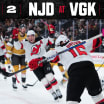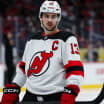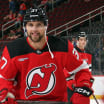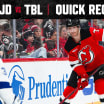Most phone calls with early-20s hockey players take a certain tone. On the surface, a rookie or second-year pro sounds about the same as talking to a college junior or senior.
It's when you delve further that you realize a hockey player's existence is different. Pro hockey is not for the faint of heart, especially when you've already been traded across the continent and especially not this season with all its pandemic-related issues.
Pro hockey forces you to grow up. Quickly. In saying that, there was something about a recent chat with Nate Schnarr that was especially notable. The 22-year-old Binghamton Devils center is not only smart, but he also analyzes situations differently for someone his age.
PROSPECT WATCH: Schnarr Takes Philosophical Approach to Development
The Devils' Schnarr has taken a winding road and philosophical approach to improving his game
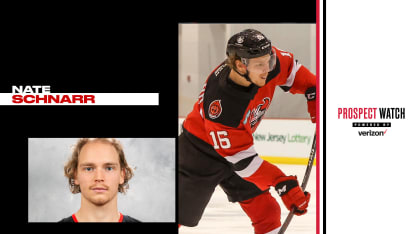
By
Peter Robinson
Special to NewJerseyDevils.com
To wit:
"Good pros never stop getting better," Schnarr said. "There is always something to learn that can help or help the team."
Or how about this one:
"I'm not going to say that this is normal," of playing in a pandemic. "Playing without fans, the protocols that need to be followed, it's different, for sure. But I'm just thankful that every day I'm allowed to go to the rink and do something I love with 20 of my friends."
Schnarr, or course, is not just a philosopher on skates. He's got an enticing physical presence (6-foot-3, 185 pounds) and an amateur resume that prompted Binghamton Devils head coach Mark Dennehy to say "you don't score 100 points in the OHL without having some serious offensive talent" when Schnarr was dealt to the organization last season in the Taylor Hall trade.
Almost two seasons into his American Hockey League career with Tucson and Binghamton, including a cross-continent move and COVID-19 doing its thing, Schnarr has played 22 games with the Roadrunners, (1G-8A), 21 with the B-Devils (2G-6A) last season and is about to cross the 20-game threshold this season (3G-5A).
Dennehy was referring to the 102 points (34G-68A) Schnarr had in his final season of junior hockey with the Guelph Storm. That led the eventual Ontario Hockey League champions in scoring, a club that also included Devils prospect Nico Daws. Those gaudy numbers aside, Schnarr doesn't project as a scorer in the pros but could play up and down the lineup given his ability to create offense.
Darren Rumble, the former NHL defenseman, had Schnarr on his club when he was the head coach of the Canadian U-18 squad at the 2017 World Championships. Two years later, Schnarr's OHL team met Rumble's Saginaw Spirit in the OHL Western Conference Final.
"He plays a pro-style 200-foot game," said Rumble of coaching and then facing Schnarr.
"The Storm were stacked, had picked up Nick Suzuki and (Nate) had taken on a different role (compared to the regular season). He was effective for them and I remember thinking at the time how that would bode well for him in pro hockey. He had learned to use his frame better as well."
As Rumble suggests, Schnarr's size should continue to be an attribute. As the game gets faster, hockey has gotten smaller. But there is always something to be said about bigger players.
"I think size is important if you know how to use it," Schnarr said. "I think of a guy like Joe Thornton, the way he uses it to protect the puck and to keep possession."
Like everyone, Schnarr has noticed some of his former B-Devils teammates such as Nathan Bastian, Yegor Sharangovich, Mikhail Maltsev now having regular roles with the big club and frequent linemate Marian Studenic recently getting called up. He's also noted other AHL players from different organizations with backstories not dissimilar to his own starting to emerge in the NHL.
As you may expect, Schnarr takes a wider view of the opportunity that someday he hopes awaits him.
"I hope to get the opportunity in the NHL this year but that is something I don't really have full control over," he said. "It's important to be ready when that opportunity comes. … management wants everyone in the organization to succeed."
There is another interesting element to Schnarr's story that dates to his days with the Storm. The OHL club plays in the ultra-tough MidWest division that has produced more than 50 current NHLers (and almost that many again in the AHL). There are just five teams - Erie, London, Kitchener and Owen Sound are the others - and the pro-like schedule of 68 games with four rounds of best-of-seven series is heavily weighted toward divisional play. In other words, more than half his games were tight, inter-divisional slugfests with some of the top teenagers in the world playing for the other side.
Current Devil Janne Kuokkanen spent a year playing for the London Knights as an 18-year-old before graduating to pro hockey the next season.
Rhyming off a list of big names he played against in junior - Suzuki, Mitch Marner, Alex DeBrincat, Matthew Tkachuk, Dylan Strome among them - Schnarr offered an interesting story.
"My rookie year, before a game against Erie, my coach said, 'you're matched against DeBrincat, Strome and (Taylor) Raddysh's line tonight," remembered Schnarr, pausing as if to add effect, "…I think playing in so many games like that (in junior) had a lot to do with my development."
From Guelph, through Tucson, and now in Bingo, that development continues.





